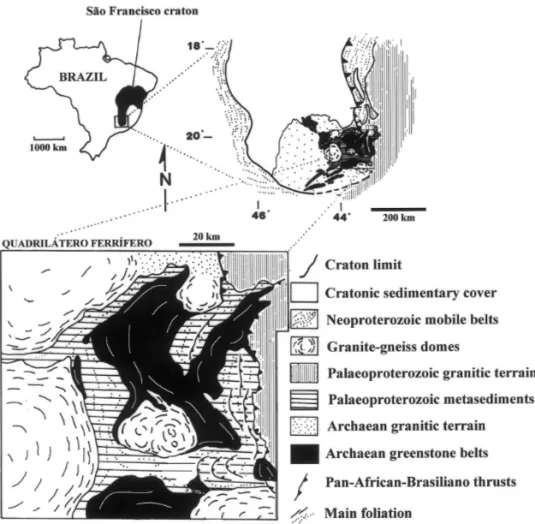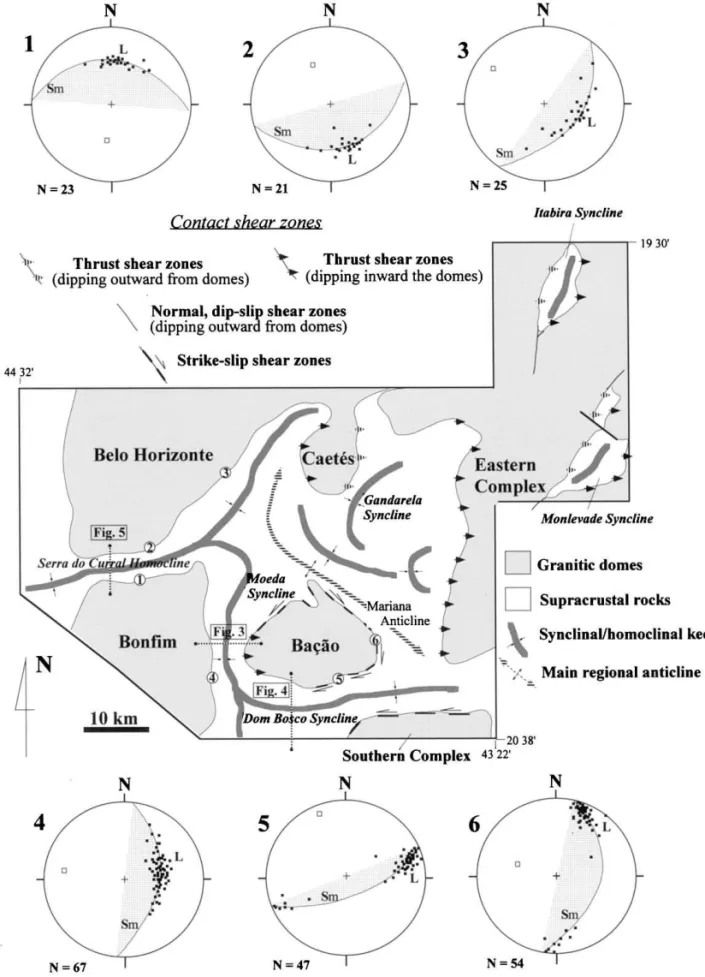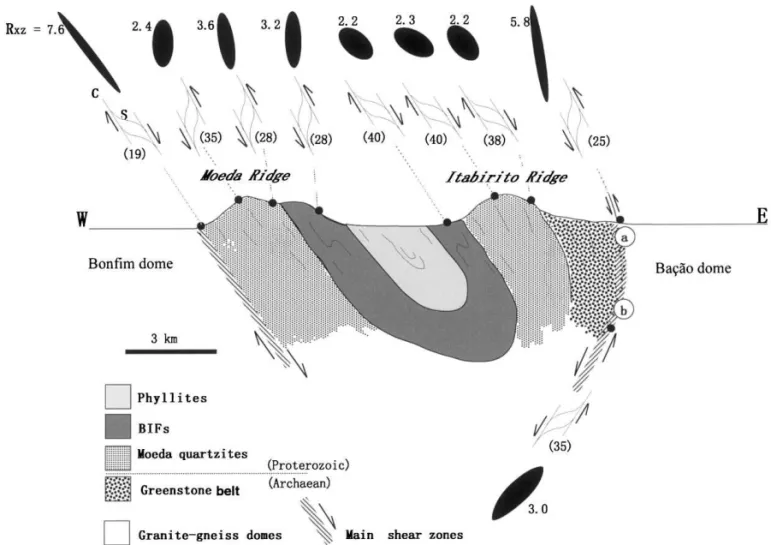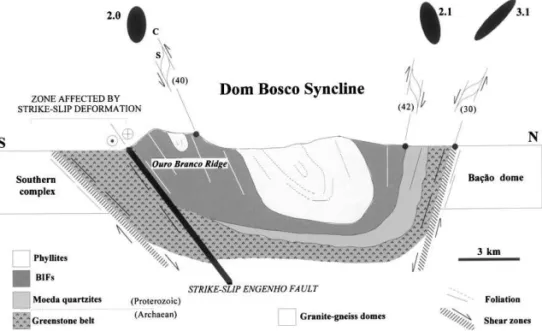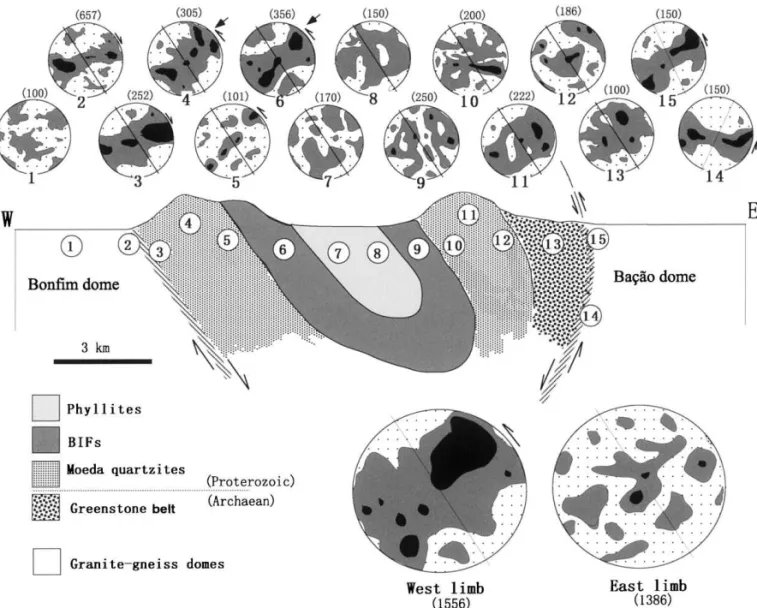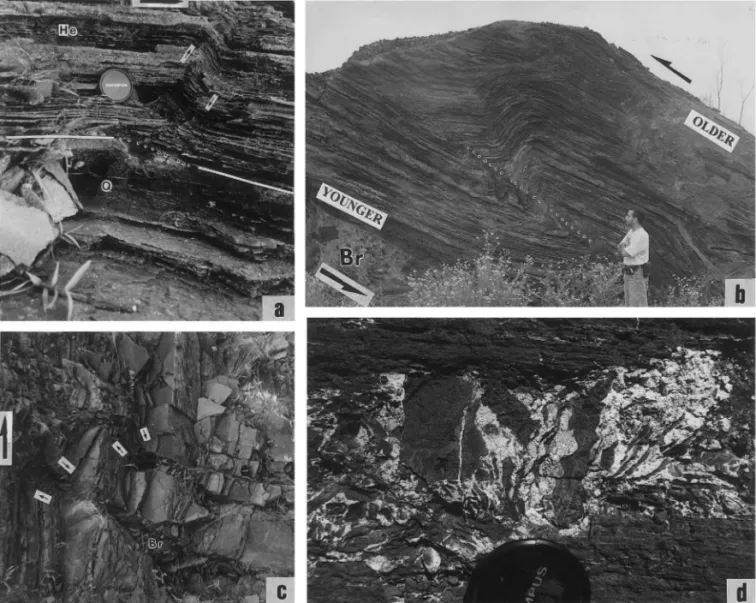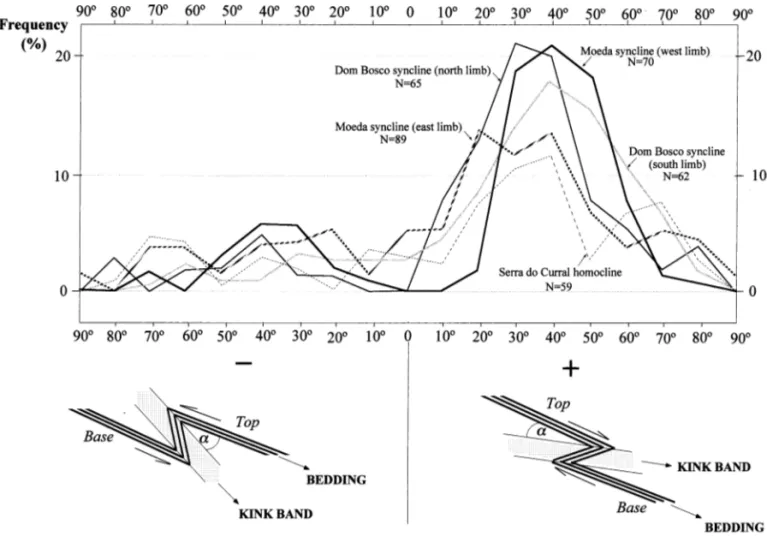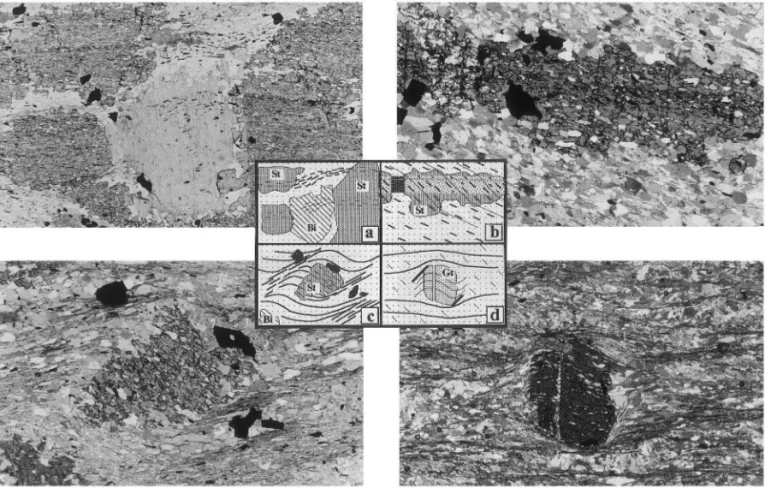Dome emplacement and formation of kilometre-scale
synclines in a granite – greenstone terrain (Quadrila´tero
Ferrı´fero, southeastern Brazil)
J. Hippertt
a,*, B. Davis
baDepartamento de Geologia,Uni
6ersidade Federal de Ouro Preto,35400-000Ouro Preto,MG,Brazil
bDelta Gold NL,P.O.Box152,Kalgoorlie,Western Australia6430,Australia
Received 11 February 1999; accepted 7 January 2000
Abstract
The Quadrila´tero Ferrı´fero is a portion of the Brazilian Precambrian shield containing a granite – greenstone terrain characterized by granite – gneiss domes encircled by kilometre-scale synclines. Integration of porphyroblast-matrix microtextures,c-axis fabrics analysis and strain analysis with outcrop-scale structural relationships indicates that the main phase of domes and synclines evolution occurred during the westerly directed 0.8 – 0.6 Ga Pan-African-Brasil-iano regional shortening. This tectonic event has produced the single pervasive foliation observed in the folded supracrustal sequences of the Quadrila´tero Ferrı´fero. Dip-slip ductile shear zones developed at the dome – supracrustal interface are synchronous with dome evolution during the Pan-African-Brasiliano deformation, as indicated by contemporaneous growth of aureole porphyroblasts in the shear planes. These shear zones facilitated steeply directed downward flow of country rock material around the granite – gneiss domes. The marked density contrast between granite – gneiss material and the iron-rich supracrustals provided a gravitationally favourable environment for downward wallrock flow. Variations in shear zone kinematics away from the domes, combined with kilometer-scale viscous drag, contributed to produce kilometre-scale synclines in the supracrustal rocks constrained between upward moving domes. © 2000 Elsevier Science B.V. All rights reserved.
Keywords:Kilometre-scale synclines; Granite – greenstone terrain; Dome emplacement
www.elsevier.com/locate/precamres
1. Introduction
A number of kilometre-scale, generally sub-cir-cular or elliptical granite – gneiss massifs display development of kilometre-scale synclines in their surrounding country rocks. Such structures in-clude intrusive granite plutons (e.g. Brun et al., 1990; Veenhof and Stel, 1991), mantled gneissic * Corresponding author. Present address: Department of
Earth and Planetary Systems Science, Hiroshima University, 739 Higashi-Hiroshima, Japan.
E-mail address: [email protected] (J. Hippertt)
domes (e.g. Jelmsa et al., 1993), and core complex structures (e.g. Holm and Lux, 1996). The forma-tion of kilometre-scale synclines is commonly in-terpreted to result from the emplacement of diapiric plutons. Integral to this interpretation is a model involving return flow of the material sur-rounding and overlying the diapir during its as-cent and emplacement within the upper level of the crust. Such processes have been invoked to explain the geometry of the surrounding synclines, which are commonly interpreted to be a reflection of mass-transfer processes that operate to provide room for the intruding pluton (see reviews by Paterson and Fowler, 1993; Paterson et al., 1996). Consequently, formation of the synclines in these models is proposed to occur synchronously with emplacement and can be independent of any con-gruous regional deformation.
Alternatively, similar geometries comprising granitic plutons surrounded by synclines have also been proposed as having formed by subsequent deformation of country rocks around the plutons during contractional deformation (e.g. Davis, 1993). However, the axial surfaces and fold axes of the synclines in these cases commonly anasto-mose around the plutons and taper off in
direc-tions at a high angle to the maximum
compression direction of regional deformation. Commonly, the plutons are considered to have acted as relatively rigid objects within the regional stress field, thereby causing strain accumulation against their margins that results in enhanced deformation in the vicinity of the contacts (e.g. Meneilly, 1983; Davis, 1993).
However, it is difficult to tell which model has operated in cases where the synclines do not define continuous encircling geometries around the plutons. Contention as to which model is most applicable has been prevalent recently in the liter-ature, particularly for plutons that were
consid-ered to be classic examples of ballooning
granitoids (e.g. Ramsay, 1989). Crucial to deter-mining which model is most appropriate is an integration of the deformation history in aureole country rocks with that recognized regionally, as the porphyroblasts grown in the aureoles can preserve foliations that have been destroyed in the matrix during subsequent deformation.
The Quadrila´tero Ferrı´fero is dominated by granite – gneiss domes with diameters in the order of a few to several tens of kilometres that are typically surrounded by kilometre-scale synclines. These structures are well exposed, including their contact with the granite – gneiss domes, and they show development of metamorphic minerals in the contact metamorphic aureoles. In this paper, microstructural and field-based information are used to interpret the deformation processes re-sponsible for syncline development associated with dome emplacement, using as an example the dome-and-keel structure of the Quadrila´tero Fer-rı´fero. A model is then proposed for dome
em-placement and syncline development that
integrates field information with microstructural data from spatially oriented thin sections.
2. Geologic and structural setting
The Quadrila´tero Ferrı´fero, one of the most important regions of the Brazilian Precambrian shield for its reserves of Fe, Mn and Au, is a granite – greenstone terrain (Schorscher, 1978) lo-cated in the southern portion of the Sa˜o Fran-cisco craton in southeastern Brazil (Fig. 1). It comprises a supracrustal sequence of Archaean metavolcanic rocks (the Rio das Velhas green-stone unit, 2.9 – 2.7 Ga) and Lower
Palaeoprotero-zoic metasedimentary rocks (the Minas
supergroup, 2.1 – 2.5 Ga), which have been region-ally metamorphosed to greenschist to lower
am-phibolite facies (Herz, 1978) during the
Transamazonian (2.1 – 2.0 Ga) and Pan-African-Brasiliano (0.8 – 0.6 Ga) orogenies. Available U – Pb zircon dating (Machado and Carneiro, 1992) indicates that the Rio das Velhas greenstone unit was deposited on an Archaean granitic – gneissic basement. Reactivation of this basement in subse-quent orogenic events (cf. Marshak et al., 1997) has produced the dome-and-keel structure of the Quadrila´tero Ferrı´fero.
(Schorscher, 1978). Mica schists, carbonatic rocks, quartzites and banded iron formations (BIFs) also occur in variable proportions as a result of low-grade metamorphism of chemical and clastic sediments, as well as volcanic rocks of intermediate-acid composition.
The overlying Palaeoproterozoic metasedimen-tary sequence, which is separated from the green-stone sequence by an erosional unconformity, is mainly composed of quartzites, mica schists, phyl-lites and carbonatic rocks. These lithologies are interpreted to represent infill of a platformal basin with a basal rift sequence overlain by marine sediments (Chemale et al., 1994). This sequence also includes a several hundred metres-thick unit of BIFs (Itabira Group) composed of quartzites with variable proportion of carbonates and Fe oxide (hematite and magnetite), which host the Fe reserves of the Quadrila´tero Ferrı´fero.
The supracrustal sequences have been folded within interconnected kilometre-scale synclines and anticlines that surround the granitic domes of the Quadrila´tero Ferrı´fero (Fig. 2). These domes generally have a complex internal structure (e.g. Hippertt, 1994a) and comprise a number of plu-tonic granitoids of granitic, granodioritic and trondjemitic composition, as well as gneisses and migmatites. Available U/Pb zircon dating indi-cates an Archaean age (2.7 – 3.2 Ga) of crystalliza-tion for these granitic rocks (e.g. Machado and Carneiro, 1992; Machado et al., 1992). However, the significance of these results is still uncertain as some of these ages were obtained in zircon cores, which may represent detrital zircons that do not necessarily reflect the crystallization age of the host granitoid (Hippertt, 1996). The contacts be-tween domes and supracrustals are generally marked by low to medium metamorphic grade shear zones with variable kinematics.
The ascent and emplacement mechanism of the granitic domes of the Quadrila´tero Ferrı´fero is a controversial topic that has already been the sub-ject of discussion in the literature (Chemale et al., 1996; Hippertt, 1996). Classical views generally favor a model involving emplacement in the mag-matic state (e.g. Herz, 1970), whereas emplace-ment of dome material in a predominantly plastic state was proposed by Hippertt (1994a). Other recent papers (e.g. Marshak et al., 1992), however, claim that solid state uplift of the domes occurred during a regional extensional tectonic event dur-ing the Transamazonian orogeny (2.1 – 2.0 Ga). Emplacement of the granitic – migmatitic domes into the relatively cooler supracrustal sequences has induced the development of porphyroblastic thermal aureoles around the domes (Marshak et al., 1992). These aureoles, firstly recognized and mapped by Herz (1978), are a crucial feature to elucidate the development of the dome-syncline architecture of the Quadrila´tero Ferrı´fero. Meta-morphic porphyroblasts within these aureoles contain preserved foliations which have enabled study of the interrelationships between deforma-tion and granite emplacement via microstructural analysis of inclusion trails and porphyroblast-ma-trix relationships (discussed below).
Recent studies (e.g. Marshak et al., 1992; Mar-shak et al. 1997; Chemale et al., 1994; Alkmim and Marshak, 1998) have summarized the tectonic evolution of the Quadrila´tero Ferrı´fero into two main tectonic cycles. The first event (2.1 – 2.0 Ga Transamazonian orogeny) has been interpreted as a period of predominant crustal extension, with some authors (e.g. Marshak et al., 1992) invoking synchronous dome emplacement and development of kilometre-scale synclines. The second major event, which has been attributed to the Pan-African-Brasiliano orogeny (0.8 – 0.6 Ga), was contractional and produced west-verging trusts in the east margin of the Quadrila´tero Ferrı´fero. Alternatively, Chauvet et al. (1994) interpreted all the main structures and metamorphic paragenesis of the Quadrila´tero Ferrı´fero region as related to the Pan-African-Brasiliano deformation and metamorphism.
2.1. Kilometre-scale synclines
The axial traces of the kilometre-scale synclines anastomose around the granitic domes (Fig. 2), forming a discontinuous keel that is approxi-mately 240 km in length and 20 km in width. In the eastern portion of the Quadrila´tero, several segments of this keel appear to be isolated at the present erosional level, but were probably origi-nally connected (Chemale et al., 1994), as sug-gested by their identical stratigraphic sequences.
Both the Archaean greenstone unit and the overlying Palaeoproterozoic metasedimentary se-quences are folded within this keel, forming tight synclinoria or, locally, overturned homoclines. The geometry of the interconnected kilometre-scale synclines varies greatly from one point to another. For example, the Moeda Syncline, west of the Bac¸a˜o complex, has its east limb progres-sively overturned towards the south where the
Bac¸a˜o complex lies on the overturned
supracrustal sequences (Fig. 3). In contrast, the Dom Bosco syncline on the southern margin of the Bac¸a˜o complex (Fig. 4), which was strongly affected by westward tectonic transport during the Pan-African-Brasiliano orogeny, has suffered superimposition of a strike-slip component. North of the Bonfim Complex, the surrounding keel is a truncated, overturned syncline that would be bet-ter described as a steeply dipping homocline (Fig. 5). In the following section, the structural/ mi-crostructural framework is described as observed in representative profiles across some sectors of the synclinal-homoclinal keel.
3. Structures and microstructures
3.1. Shear zones
Fig. 3. Sketch showing distribution of S – C fabrics and XZ finite strain ellipses in a profile across the overturned Moeda syncline (see Fig. 2 for location). Numbers between parenthesis indicate average angle between S- and C-foliations in each domain. The axial rate (Rxz) is indicated for each ellipse. In the eastern portion of the profile, ‘a’ and ‘b’ represent local variations in the orientation of the contact shear zone. Note that a higher finite strain was produced in the west limb which is not overturned (see text).
upward movement of the domes. The downward movement of encompassing supracrustal material appears to have been steeply directed, rather than accommodated by strike-slip movements, as indi-cated by stretching lineations that generally pitch steeply (70 – 90°) in the shear planes (Fig. 2). Thus, these marginal shear zones are extensional (normal) where the syncline limbs are not over-turned, but record a reverse sense of movement where the contact plane dips towards the domes (Fig. 3). Strike-slip and thrust components have also been detected at other contacts (e.g. around the Bac¸a˜o and Caete´s domes, respectively; Fig. 2). These variations in the kinematics of the granite – supracrustals contact have been previously inter-preted either as post-emplacement tectonic effects
(e.g. Chemale et al., 1994) or aureole effects dur-ing dome ascent (Hippertt, 1994a).
Metamorphic assemblages in these shear zones (e.g. muscovite – chlorite – epidote; muscovite – bi-otite – garnet) are compatible with deformation under greenschist/lower amphibolite facies condi-tions, suggesting that these shear zones were ac-tive during imposition of regional low to medium grade metamorphism that affected most of the Quadrila´tero Ferrı´fero region during the 0.8 – 0.6 Ga Pan-African-Brasiliano orogeny (Chemale et
al., 1994). The shear zones affect both
the granitic rocks, deformation was principally accommodated via crystal-plasticity and solution-transfer processes in quartz and retrograde soften-ing reactions in feldspar (Hippertt, 1998). In the supracrustal rocks, crystal plasticity of carbonates and slip on basal planes of mica were also impor-tant, and accommodated much of the shearing
component of the deformation (Davis, 1993, 1995).
Bedding-parallel ductile shear zones occur throughout the synclines. These shear zones vary in width from millimetres to a few decimetres in width, and generally occur at the interface be-tween beds of contrasting composition and
rheol-Fig. 4. S – C fabrics and XZ finite strain ellipses across the normal Dom Bosco syncline (see rheol-Fig. 2 for location). The southern limb was strongly affected by a later strike-slip deformation that partially obliterated the S – C fabrics and the strain ellipses related to the syncline development. Note shear sense reversal in the northern limb (see text).
ogy. The sense of shear in these interlayer shear zones is in most cases consistent with a downward movement of the older beds. Thus, the kinematics of this internal shear zones is opposite to the contact shear zones, which has commonly pro-duced an abrupt reversal in sense of shear a few tens of metres away from the dome – supracrustals interface, as observed in the west margin of the Moeda Syncline (Fig. 3).
3.2. Clea6ages, S–C fabrics, oblique fabrics and
strain ellipses
There is a single pervasive cleavage developed in the supracrustal rocks all over the synclinal keel of the Quadrila´tero Ferrı´fero. This cleavage is generally parallel to, or maintains a low angle obliquity to bedding (B15 – 20°), suggesting con-tinued bedding-parallel shear during folding. In the hinge zones of the kilometre-scale synclines, however, the plane axial character of this cleavage is revealed in some outcrop scale folds.
S – C fabrics and oblique grain shape fabrics are also common in the folded supracrustal se-quences. S – C fabrics of microscopic, hand speci-men and outcrop scales are dominant in both the internal and marginal shear zones (Fig. 6), and possess unambiguous asymmetries consistent with the shear sense inferred from independent criteria such as shear bands and displacement of quartz veins. Oblique fabrics, generally defined by a dis-continuous mica foliation or grain shape fabrics in quartz aggregates are widespread in domains between consecutive shear zones. The asymmetry of these shape fabrics provides reliable shear sense indicators (Simpson and Schmid, 1983). The shape fabrics show opposite geometries on differ-ent synclinal limbs with reversals in asymmetry occurring generally close to the syncline axis.
XZ finite strain ellipses were determined by the Fry (1979) method in oriented thin sections of porphyroclastic quartzose horizons with low
de-grees of recrystallization in all the main strati-graphic units across the profiles shown in Figs. 3 – 5. The ellipses generally show opposite obliqui-ties in the different syncline limbs, consistent with the variation in the asymmetry of S – C fabrics. The most elongate finite strain ellipses were deter-mined in the contact shear zones between domes and supracrustals. In addition, inverted syncline limbs, such as the east limb of the Moeda syn-cline, tend to record smaller degrees of finite strain than the normal limbs (Fig. 3).
3.3. Quartz c-axis fabrics
Quartz c-axis fabrics in sheared granitoids and supracrustals have been investigated with variable degrees of finite strain throughout the profile that crosscuts the Moeda syncline (Fig. 7). Both mar-ginal and internal shear zones show predominant asymmetric single girdle c-axis fabrics, which typ-ically form during progressive simple shear (Schmid and Casey, 1986). The asymmetry of this fabric, however, is not always coincident with that indicated by S – C fabrics, oblique fabrics and other independent criteria. This is a common problem in shear zones, which generally prevents utilization of c-axis fabrics as a reliable shear sense indicator (Hanmer and Passchier, 1991). The important inference, however, is that these single girdle fabrics reflect a predominant non-coaxial deformation in both the contact zone and between the sedimentary beds in the interior of the synclines. In contrast, the less deformed do-mains between pairs of consecutive shear zones, i.e. the interior of the sedimentary beds, show weaker asymmetric cross girdle fabrics (Fig. 8), which are currently interpreted to be a product of general strain regimes with components of both pure shear and simple shear (Lister and Hobbs, 1980). Occasionally, near-symmetric cross girdle fabrics have also formed in these domains, reflect-ing a local strain regime close to ideal pure shear.
These variations in c-axis fabrics are also de-tectable at the thin-section scale in metasediments that are finely laminated. In these rocks, domains that are only a few millimetres thick in the
limit-ing zone between two sedimentary beds show an asymmetric single girdle fabric, while the quart-zose matrix inside the beds shows a more symmet-ric fabsymmet-ric. These crystallographic fabsymmet-rics are
Fig. 7. Quartzc-axis fabrics determined across the overturned Moeda syncline. Numbers between parenthesis indicate number of grains measured in each diagram. The two larger diagrams represent overallc-axis fabrics for each syncline limb. Density contours are 1.25 and 2.75% per 1% area.
consistent with the overall distribution of shear zones and S – C fabrics within the synclines and reflect well-organized strain partitioning between interlayer and intralayer domains during syncline development (discussed below).
3.4. Folds
Numerous parasitic folds are represented on the limbs of the first-order folds that define the kilo-metre-scale synclines, with fold geometries evident down to the thin-section scale. Metasedimentary lithologies with different rheologic properties show contrasting folding patterns. The hematite-rich layers in the BIF unit show the most complex and tight fold geometries (Fig. 6d), whereas folds in the quartz-rich units are much more open and regular. Folds in the hematite-rich layers, and also in some phyllitic horizons, are intrafolial and commonly grade into kinks (see below), their asymmetry being generally opposite to the bed-ding-parallel shear inferred from S – C fabrics and other criteria.
Outcrop scale, open to moderately tight folds showing a plane axial cleavage are also common in the hinge zones of the kilometre-scale synclines, principally in the more pelitic lithologies. The geometry and orientation of the majority of these folds, with fold axis generally subparallel to the syncline keel axis, suggest they are also smaller scale folds related to development of the kilome-tre-scale synclines. However, a minor proportion of tight folds with fold axis oblique or perpendic-ular to the syncline axis are observed locally in some sectors of the folded supracrustal sequences (cf. Chemale et al., 1994), and may in part repre-sent preserved folds related to the
Palaeoprotero-zoic Transamazonian orogeny (Alkmim and
Marshak, 1998).
3.5. Kinks
Kinks are well developed in the hematite-rich layers of the BIFs because of comparatively lesser competency of this lithology relative to the sur-rounding quartz-rich layers (Fig. 9). Where the hematite content is relatively less, kinks com-monly display a smooth transition into
asymmet-ric intrafolial folds (drag folds). The orientations of the kink planes are variable but generally define an average oblique angle with lithological layering of 30 – 50°, dipping inward into the syn-clines. Hence, dip directions of kink planes reverse on opposite syncline limbs. The kink pattern is commonly very complex, with the appearance of secondary kinks at a large range of scales. Fig. 10 summarizes the orientation of kink planes ob-tained in the studied sectors of the synclinal keel. Brecciated zones with variable magnitudes and orientations are intimately associated with the most intensely kinked BIFs (Fig. 9b – c), the thick-est breccias generally occurring adjacent to the displaced younger strata. There appears to be a direct relationship between the dip angle of the hematite-rich layer and the complexity of the kink pattern, subvertical and overturned layers gener-ally showing the most intense kinking. The inten-sity of kinking is also directly related to the overall Fe oxide content (hematite and magnetite) of the BIF layers. Layers with 80 – 90% of he-matite tend to show the most complex kinking patterns. These relationships suggest that this complex kinking pattern may be the result of intrafolial gravitational collapse of the high-den-sity hematite-bearing layers during syncline for-mation (discussed below).
3.6. Porphyroblasts
Porphyroblast growth represented by muscovite and, more locally, kyanite porphyroblasts are common throughout the metasedimentary se-quences of Quadrila´tero Ferrı´fero. In domains adjacent to the granitic domes, however, a meta-morphic aureole, whose width varies between a few to several hundred metres, is generally present and is characterized by the presence of staurolite and biotite porphyroblasts. These aureoles reflect a higher temperature of metamorphism in do-mains adjacent to domes. In this section, porphy-roblast textures observed in these aureoles are described.
Fig. 9. (a) Kink band in a hematite-rich banded iron formation (BIF) layer (He). Note how the kink band does not propagate into adjacent quartzite layer (Q), indicating the intrafolial character of this structure. Width of view is 65 cm. (b) Overturned and intensely kinked BIF strata in the west end of the Serra do Curral homocline. Note relative downward movement of younger strata and the brecciated zone adjacent to it (see text). The main kink plane is also indicated (dotted line). (c) Complex pattern of kinks and fractures in BIF layers of the west limb of the Moeda Syncline. Note that some kink bands modify into breccia zones (Br). Small arrows indicate the relative movements on individual kink planes. Width of view is 1.6 m. (d) Detail of a brecciated zone in BIF layers. The white matrix is carbonate-rich. Width of view is 25 cm.
these rocks occur on the northern end of the Bonfim dome near the townships of Brumadinho and Ibirite´ (see Jordt-Evangelista et al., 1992; Marshak et al., 1992). Porphyroblasts at these localities are several millimetres across. A perva-sive schistosity is evident in outcrop and is sub-parallel to lithological layering (bedding), which is commonly defined by porphyroblast-poor quart-zose layers and porphyroblast-rich pelitic hori-zons. Elongate porphyroblasts, in particular
biotite, commonly define a well-developed down-dip stretching lineation.
pervasive foliation evident in outcrop all over the Quadrila´tero Ferrı´fero and defined by the shape-preferred orientation of mica and quartz grains. This foliation is generally subparallel to bedding but attains angles of approximately 10° to it in zones where the percentage of quartz dominates over that of biotite. Inclusion trails defined by quartz and opaques (ilmenite and magnetite) are continuous with the dominant matrix foliation, and porphyroblasts commonly preserve an angu-lar relationship between bedding and this fabric that is greater than that in the matrix (Fig. 10b). This is suggestive of continued shearing in an orientation subparallel to bedding, which
oc-curred after growth and preservation of original foliation/bedding asymmetries.
A more local deformation is expressed as crenu-lations, which are locally differentiated and gener-ally restricted to mica-rich pelitic horizons. The best development of crenulations in the pelitic horizons is largely due to the presence of porphy-roblasts, which have acted as rigid objects against which accumulation of shortening strain has oc-curred. This strain intensification has produced local zones of phyllosilicate concentration on the porphyroblast margins (Fig. 10c).
Both staurolite and biotite porphyroblasts have overgrown the pervasive matrix foliation
Fig. 11. Photomicrographs of aureole porphyroblasts from the Quadrila´tero Ferrı´fero. (a) Biotite porphyroblast bordered by staurolite porphyroblasts, both of which include bedding as inclusion trails parallel to the long edge of the photo. Note that inclusion trails in the biotite display more pronounced curvature than those in staurolite, which is consistent with progressive low-medium grade metamorphism (i.e. biotite after staurolite) concurrent with progressive deformation. Sample is from northern end of Bonfim dome. Long edge of photo is 4.0 mm. (b) Staurolite porphyroblast that has grown along a phyllosilicate-rich layer defining bedding. Opaques and quartz inclusions define inclusion trails with an angular relationship with bedding, which are continuous with the matrix foliation. Sample is from northern end of Bonfim dome. Long edge of photo is 1.0 mm. (c) Intensification of cleavage on the margin of the staurolite porphyroblast where strain accumulation has occurred. Matrix comprised of muscovite and quartz. Sample is from northern end of Bonfim dome. Long edge of photo is 2.0 mm. (d) Garnet porphyroblast including a small biotite porphyroblast and displaying sigmoidal inclusion trails that are continuous with a weakly curved foliation in the matrix. Progressive deformation has caused strain accumulation against the porphyroblast margin resulting in phyllosilicate concentration. Matrix is comprised of muscovite and quartz. Sample is from location adjacent to contact of the Bac¸a˜o complex. Long edge of photo is 2.0 mm. Polars partly crossed in all photos.
ated with the main deformation event. The greater degree of curvature preserved in biotite relative to that in staurolite porphyroblasts (e.g. Fig. 11a), combined with further intensification of matrix crenulations against the porphyroblast margins, suggests growth of the biotite during the main deformation but after staurolite. Relative over-growth textures confirm these microstructural relationships.
Similar porphyroblast – matrix relationships oc-cur between biotite and staurolite porphyroblasts
4. Interpretations and discussion
4.1. Gra6itational structures
The complex kink pattern that typically occurs in the BIF layers of the Quadrila´tero Ferrı´fero has been interpreted by previous workers (e.g. Chemale et al., 1994) to result from a polydefor-mational tectonic evolution that could have oc-curred in this region. Kink distributions and geometries have been investigated in different sec-tors of the syncline keel (Fig. 10), and the conclu-sion is that their geometry is extremely variable and is not consistent with those present in other lithologies. The critical point in understanding the origin of these kinks is that they are more abun-dant in syncline sectors where the BIF layers are steeply dipping (\60°). In addition, BIF layers in inverted syncline limbs typically host the most complex kink patterns. The intensity of kinking is also directly related to the local hematite/ mag-netite content in the individual BIF layers. These relationships, combined with the observation that the kinks are nearly always in an orientation that reflects slip downwards of the overlying younger strata over the older ones (even when the strata are inverted as in Fig. 9b), is herein interpreted as being indicative of gravitational collapse of denser BIF layers [density (D) varies between 3.4 and 4.8, depending on the Fe oxide content] relative to the adjacent, less dense lithologies (e.g. quartzite, phyllites, carbonatic rocks; with DB2.9), as shown schematically in Fig. 12.
4.2. Kinematic framework during syncline de6elopment
The single pervasive foliation present in the folded supracrustal sequences is subparallel or has a low angle obliquity to bedding all over the synclinal-homoclinal keel. The opposite sense of shear in each syncline limb, as indicated by all meso- and microstructural shear sense indicators, and the pronounced strain partitioning between intralayer domains (with predominant coaxial de-formation) and interlayer domains (with predomi-nant simple shear), as indicated by c-axis patterns, are all consistent with a general
kine-matic framework with local and regional strain components. This is particularly clear in inverted synclines such as the Moeda syncline (Fig. 3). The existence of opposite senses of layer-parallel shear in different limbs is interpreted to reflect the oper-ation of flexural slip/flow (Tanner, 1989) during syncline development at low/medium metamor-phic grade conditions. This is corroborated by the fact that most of the slip is accommodated be-tween the sedimentary strata (where a strong rhe-ologic contrast occurs) via bedding parallel, interlayer shear. In contrast, the interior of the strata have been important for localizing the pure shear component (indicated by the existence of cross-girdle c-axis fabrics; Fig. 8), which reflects the bulk shortening direction of finite strain dur-ing the syncline closure. Evidence for brittle de-formation of quartz (Fig. 8b) indicates that deformation occurred at temperatures below 300 – 350°C and/or at relatively fast strain rates (Pass-chier and Trouw, 1996), therefore preventing pervasive ductile flow in the supracrustal rocks. At these rheologic conditions, flexural slip/flow appears to be a suitable mechanism to accommo-date folding (Tanner, 1989).
inver-sion induced a non-coaxial strain component that interacted in different ways in each limb with the non-coaxial component derived from flexural slip (Fig. 13b). Thus, in overturned limbs, the regional simple shear component derived from the dome movement that caused the syncline inversion op-posed the simple shear derived from flexural slip,
so that a smaller finite strain was produced in these domains. In contrast, in the normal, non-in-verted limbs these two non-coaxial components were synthetic, leading to a higher finite strain in these domains. This scenario is consistent with all microstructural and kinematic information col-lected across the asymmetric Moeda syncline.
4.3. Granite emplacement, syncline de6elopment
and aureole structures
Explanation of processes involved in the de-velopment of the different types of dome – supracrustal structures such as intrusive plutons and core complexes invokes the necessity to con-sider mass transfer processes that must occur to make space available, as deformation in the structural aureoles only provide accommodation of 15 – 35% of the country rock material that had to be displaced to allow granitic plutons to be emplaced (Paterson and Fowler, 1993). As a consequence, mass transfer processes necessarily involved a downward movement of the country rock. Similarly, published studies of Archaean granite – greenstone terrains have invoked the process of diapirism, with upwelling of relatively less dense granitic material through surrounding greenstones (e.g. Anhaeusser, 1984; Hickman, 1984; Bouhallier et al., 1993; Jelmsa et al., 1993; Pons et al., 1995; Chardon et al., 1998). Al-though these examples involve emplacement of igneous plutons, the same space problems and mass transfer considerations must be taken into
account during development of dome –
supracrustal structures by solid-state processes during basement reactivation, such as occurs in the Quadrila´tero Ferrı´fero dome-and-keel struc-ture and in other mantled gneisses and core complexes (Marshak et al. 1997).
The pervasive development of shear zones at the dome – supracrustal contacts, which generally display steep down-dip lineations and dome-side-up senses of shear, is consistent with downward flow of supracrustal sequence. This would ap-pear to be a mechanically viable process because no work need be done against gravity (e.g. Pa-terson and Miller, 1998) during downward trans-fer of the relatively more dense supracrustals. The gravitational collapse of the denser BIF lay-ers and the solution transfer mechanisms in the marginal shear zones (e.g. Hippertt, 1994b), along with attenuation of syncline limbs closest to the domes, provide examples of such mass transfer processes in the Quadrila´tero Ferrı´fero dome-syncline architecture.
Kilometre-scale synclines display close spatial relationships to the domes, and pronounced staurolite/biotite porphyroblast growth is spa-tially restricted to the margins of the domes. This suggests that dome formation is linked both to syncline development and porphyroblast growth. This contention is further supported by the steep down-dip preferred orientations of metamorphic minerals in the shear zones, which represent stretching lineations on the foliation that has accommodated the shearing strain.
Previous authors (e.g. Marshak and Alkmin, 1989; Chemale et al., 1994) have suggested that the earliest deformation in the Quadrila´tero Fer-rı´fero was represented by a Palaeoproterozoic extensional event that was also responsible for formation of the granite – gneiss domes and nu-cleation of the regional synclines. Alternatively, Chauvet et al. (1994) have attributed the devel-opment of these structures to the
Pan-African-Brasiliano contractional deformation. The
intensification of foliation development adjacent to porphyroblasts during the event in which they grew is also more suggestive of contractional de-formation (e.g. Bell and Cuff, 1989; Vernon, 1989; Davis, 1993, 1995), the critical criterion for syntectonic growth being that inclusion trails are continuous with the matrix foliation (e.g. Johnson and Vernon, 1995). In addition, por-phyroblast growth (staurolite, biotite, garnet) re-stricted to the margins of the domes and occurred during the main fabric-forming defor-mation expressed by pervasive foliation develop-ment in the country rock of both the Bac¸a˜o and Bonfim domes. In summary, the above observa-tions are found to be consistent with interpreta-tions such as those of Chauvet et al. (1994), who
suggested that the main structures of the
4.4. Model for dome emplacement and syncline de6elopment
Given the above relationships and interpreta-tions, a model for formation of the domes was suggested (Fig. 14) which is compatible with the geometry of the surrounding synclines, timing of porphyroblast growth in the aureoles, kinematics of the shear zones, and structures at all scales. Initiation of dome formation could have occurred early during the Palaeoproterozoic extensional event, with development of basement heterogenei-ties that acted as dome precursors as suggested by Marshak et al. (1992) and Chemale et al. (1994).
This extensional tectonics was synchronous with pronounced anatexis and granite formation (e.g. Machado et al., 1992) probably due to stress release and associated water access into the Ar-chaean basement. However, there is no evidence that this Palaeoproterozoic event has produced any pervasive cleavage, there being a single perva-sive foliation defined by muscovite – quartz – (chlo-rite) all over the Quadrila´tero Ferrı´fero region which is most likely 0.8 – 0.6 Ga old (Chauvet et al., 1994). Subsequent to this earliest extensional deformation, there was a change in deformation regime to one of west-directed compression dur-ing the 0.8 – 0.6 Ga Pan-African-Brasiliano
Fig. 14. Suggested model for the development of the dome/syncline architecture of the Quadrila´tero Ferrı´fero. Stage 1 represents original basement/supracrustals structure prior to Proterozoic orogenies. Stage 2 illustrates the 2.1 – 2.0 Ga Transamazonian extensional tectonic event (cf. Marshak and Alkmin, 1989), when normal faults and dome/syncline precursors may have formed. Downward H2O flow through normal faults favoured partial melting and granite magmatism in this period. Stage 3 represents the
orogeny, which accentuated the kilometre-scale basement heterogeneities and caused nucleation and amplification of synclinal structures in paral-lel with basement reactivation and dome ascent (Hippertt, 1994a). The enhanced development of cleavage synchronous with porphyroblast growth in the structural aureoles around the domes sug-gests that dome-induced deformation processes may have been important and operated in parallel with this regional compression. Alternatively, this can be explained as an effect of strain localization around the developing domes, which would have behaved as comparatively rigid objects relative to the country rocks in a compressive regional stress field.
Progressive shortening induced upward move-ment and amplification of domal structures through solid state deformation (Hippertt, 1994a), with mass transfer processes causing return flow of supracrustal material on the dome margins, thereby accentuating synclinal geometries. Similar processes have been invoked by Bloem et al. (1997) who suggested that kilometre-scale struc-tures in the granite – greenstone terrain of the Bullfinch – Parker Dome area, Western Australia, occurred due to regional shortening broadly simultaneous with upward movement of grani-toids by solid-state diapirism and/or ballooning plutonism.
Synclinal development in the Quadrila´tero Fer-rı´fero was enhanced on the eastern and western margins of the domes due to the concentration of strain resulting from WNW-directed shortening
and synchronous downward movement of
supracrustal rocks. Porphyroblast growth associ-ated with dome development occurred early in the compressional stages of the 0.8 – 0.6 Ga Pan-African-Brasiliano deformation. Continued pro-gressive deformation caused strain accumulation on porphyroblast margins, resulting in zones of enhanced phyllosilicate concentration and local cleavage differentiation. Shear zones marginal to the domes formed progressively during this defor-mation and aided movement of the supracrustal material around the flanks of the dome, develop-ing syn-kinematic metamorphic assemblages com-patible with the greenschist/lower amphibolite facies metamorphism responsible for
porphyrob-last growth in the structural aureoles. These shear zones were operative at this stage and accommo-dated downward flow of supracrustal material in tandem with relative upward movement of the domes, as indicated by shear zone kinematics and the preferred growth of metamorphic minerals along the shear planes. Progressive shortening would have enhanced cleavage and shear zone development, with further tightening of the synclines.
5. Conclusions
1. The main processes for dome emplacement and syncline formation were operative during de Pan-African-Brasiliano crustal contraction.
Im-portant processes were steeply directed
supracrustal wall-rock flow around the domes, accommodated largely by synchronous develop-ment of high-strain shear zones coincident with the dome – supracrustal contacts and spaced bed-ding-parallel shear related to flexural slip/flow. The relative movements of supracrustals and dome material, and the changes in shear zone kinematics away from the domes, caused kilome-tre-scale variations in viscous drag of the country rocks, producing kilometre-scale synclines. Heat supplied by the ascending granite – gneiss domes, as they came from deeper (and heater) crustal levels due to basement reactivation (cf. Marshak et al., 1992), induced development of thermal metamorphic aureoles with staurolite and biotite porphyroblasts. Strain accumulation at the supracrustal – dome interface, the density contrast between supracrustals and granite – gneisses, and contractional deformation during westerly-di-rected Pan-African-Brasiliano shortening all aided in formation of the synclines, with the downward flow of denser supracrustals being a gravitation-ally favourable process.
the pervasive nature of the Pan-African Brasiliano foliation and providing structural timing criteria for emplacement of the domes, contact-parallel shear zones and kilometre-scale synclines.
3. Kilometre-scale structures such this domes-synclines architecture in the Quadrila´tero Ferrı´f-ero are a good natural laboratory for studying how local and regional stress – strain components may interact and influence the resulting structural geometries. Kilometre-scale folding of very het-erogeneous sedimentary sequences containing lay-ers with a higher density than the surrounding lithologies (such as the BIFs in the syncline keel) may be an ideal situation for gravitational col-lapse of the denser lithologies, giving rise to com-plex structures and geometries that do not necessarily reflect the regional tectonic stress field. Such gravity-impelled processes contribute to the global mass transfer during syncline development in low to medium grade metamorphic ambients, but should exert a decreasing role downward in the crust where more cohesive deformation pro-cesses such as dislocation- and diffusion-assisted deformation gain importance.
Acknowledgements
Hippertt thanks for financial support from FAPEMIG (process CEX 117/95) and CNPq re-search grants (processes 452943/97-3 e 521847/ 95-8). Davis conducted this research while holding an Australian Postdoctoral Fellowship. Vitalino aided in field logistics and location of key out-crops. Reginaldo Silva contributed with discus-sions and photos for Fig. 6(b) and 9(b). Journal reviews were made by R. Caby and an anony-mous reviewer.
References
Alkmim, F., Marshak, S., 1998. Transamazonian orogeny in the southern Sa˜o Francisco craton region, Minas Gerais, Brazil: evidence for Paleoproterozoic collision and collapse in the Quadrila´tero Ferrı´fero. Precambrian Res. 90, 29 – 58. Anhaeusser, C.R., 1984. Structural elements of Archaean granite – greenstone terranes as exemplified by the Barber-ton Mountain Land, southern Africa. In: Kro¨ner, A.,
Greiling, R. (Eds.), Precambrian Tectonics Illustrated. Schweizerbart’sche Verlagsbuchhandlung, Stuttgart, pp. 57 – 78.
Bell, T.H., Cuff, D., 1989. Dissolution, solution transfer, diffusion versus fluid flow and volume loss during defor-mation/metamorphism. J. Metamorphic Geol. 7, 425 – 447. Bloem, E.J.M., Dalstra, H.J., Ridley, J.R., Groves, D.I., 1997. Granitoid diapirism during protracted tectonism in an Archaean granitoid – greenstone belt, Yilgarn Block, West-ern Australia. Precambrian Res. 85, 147 – 171.
Bouhallier, H., Choukroune, P., BallA` vre, M., 1993. Di-apirism, bulk homogeneous shortening and transcurrent shearing in the Archaean Dharwar craton: the Holenar-sipur area, southern India. Precambrian Res. 63, 43 – 58. Brun, J.P., Gapais, D., Cogne, J.P., Ledru, P., Vigneresse,
J.L., 1990. The Flamanville Granite (Northwest France): an unequivocal example of a syntectonically expanding pluton. Geol. J. 25, 271 – 286.
Chardon, D., Choukroune, P., Jayananda, M., 1998. Sinking of the Dharwar Basin (South India): implications for Ar-chaean tectonics. Precambrian Res. 91, 15 – 39.
Chauvet, A., Faure, M., Dossin, I., Charvet, J., 1994. A three-stage structural evolution of the Quadrila´tero Ferrı´f-ero: consequences for the Neoproterozoic age and the formation of gold concentrations of the Ouro Preto area, Minas Gerais, Brazil. Precambriam Res. 68, 139 – 167. Chemale, F., Rosie´re, C.A., Endo, I., 1994. The tectonic
evolution of the Quadrila´tero Ferrı´fero, Minas Gerais, Brazil. Precambrian Res. 65, 25 – 54.
Chemale, F., Rosie´re, C., Souza-Gomes, N., 1996. Structures indicative of helicoidal flow in a migmatitic diapir (Bac¸a˜o complex, southeastern Brazil) by J.F. Hippertt: comment. Tectonophysics 267, 343 – 345.
Davis, B.K., 1993. Mechanism of emplacement of the Canni-bal Creek Granite with special reference to timing and deformation history of the aureole. Tectonophysics 224, 337 – 362.
Davis, B.K., 1995. Regional-scale foliation reactivation and re-use during formation of a macroscopic fold in the Robertson River Metamorphics, north Queensland, Aus-tralia. Tectonophysics 242, 293 – 311.
Fry, N., 1979. Random point distributions and strain measure-ments in rocks. Tectonophysics 60, 89 – 105.
Gomes, C., 1989. Estudos microtexturais nos xistos Nova Lima, na borda do Complexo de Bac¸a˜o, Quadrila´tero Ferrı´fero, MG. Revista da Escola de Minas 42, 3 – 6. Hanmer, S., Passchier, C., 1991. Shear-sense indicators: a
review. Geol. Surv. Can. 90, 1 – 72.
Herz, N., 1970. Gneissic and igneous rocks of the Quadrila´tero Ferrı´fero, Minas Gerais, Brazil. U.S. Geol. Surv. Prof. Pap. 641, B1 – B58.
Herz, N., 1978. Metamorphic rocks of the Quadrila´tero Ferrı´f-ero, Minas Gerais, Brazil. U.S. Geol. Surv. Prof. Pap. 641, C1 – C81.
Hippertt, J., 1994a. Structures indicative of helicoidal flow in a migmatitic diapir (Bac¸a˜o Complex, southeastern Brazil). Tectonophysics 234, 169 – 196.
Hippertt, J., 1994b. Microstructures and c-axis fabrics indica-tive of quartz dissolution in sheared quartzites and phyl-lonites. Tectonophysics 229, 141 – 163.
Hippertt, J., 1996. Structures indicative of helicoidal flow in a migmatitic diapir (Bac¸a˜o Complex, southeastern Brazil): reply. Tectonophysics 267, 347 – 349.
Hippertt, J., 1998. Breakdown of feldspar, volume gain and lateral mass transfer during mylonitization of granitoid in a low metamorphic grade shear zone. J. Struct. Geol. 20, 175 – 193.
Holm, D., Lux, D., 1996. Core complex model proposed for gneiss dome development during collapse of the Pale-oproterozoic Penokean orogen, Minnesota. Geology 24, 289 – 384.
Jelmsa, H.A., van der Beek, P.A., Vinyu, M.L., 1993. Tectonic evolution of the Bindura – Shamva greenstone belt (north-ern Zimbabwe): progressive deformation around diapiric batholiths. J. Struct. Geol. 15, 163 – 176.
Johnson, S.E., Vernon, R.H., 1995. Inferring the timing of porphyroblast growth in the absence of continuity between inclusion trails and matrix foliations: can it be reliably done? J. Struct. Geol. 17, 1203 – 1206.
Jordt-Evangelista, H., Alkmim, F., Marshak, S., 1992. Meta-morfismo progressivo e a ocorreˆncia de treˆs polimorfos de de Al2SiO5 na formac¸a˜o Sabara´, Ibirite´, Quadrila´tero Ferrı´fero, MG. Revista da Escola de Minas. Ouro Preto 45, 157 – 160.
Lister, G., Hobbs, B., 1980. The simulation of fabric develop-ment during plastic deformation and its application to quartzite: the influence of deformation history. J. Struct. Geol. 2, 355 – 370.
Machado, N., Noce, C., Ladeira, E., Belo de Oliveira, O., 1992. U – Pb geochronology of Archean magmatism and Proterozoic metamorphism in the Quadrila´tero FerrI`fero, southern Sa˜o Francisco craton, Brazil. Geol. Soc. Am. Bull. 104, 1221 – 1227.
Machado, N., Carneiro, M., 1992. U-Pb evidence of late Archean tectono-thermal activity in the southern Sa˜o Francisco shield, Brazil. Can. J. Earth Sci. 29, 2341 – 2346. Marshak, S., Alkmin, F., 1989. Proterozoic contraction/ exten-sion tectonics of the southern Sa˜o Francisco region, Minas Gerais, Brazil. Tectonics 8, 555 – 571.
Marshak, S., Alkmim, F., Jordt-Evangelista, H., 1992. Proterozoic crustal extension and the generation of
dome-and-keel structure in an Archaen granite – greenstone ter-rain. Nature 357, 491 – 493.
Marshak, S., Tinkham, D., Alkmim, F.F., Brueckner, H., Bornhorst, T., 1997. Dome-and-keel provinces formed dur-ing Paleoproterozoic orogenic collapse — Diapir clusters, core complexes, or neither? Examples from the Quadri-latero Ferrifero (Brazil) and the Penokean Orogen (USA). Geology 25, 415 – 418.
Meneilly, A.W., 1983. Development of early composite cleav-age in pelites from West Donegal. J. Struct. Geol. 5, 83 – 97.
Passchier, C., Trouw, R., 1996. Microtectonics. Springer-Ver-lag, Berlin, p. 289.
Paterson, S.R., Fowler, T.K., 1993. Re-examining pluton em-placement processes. J. Struct. Geol. 15, 191 – 206. Paterson, S.R., Miller, R.B., 1998. Magma emplacement
dur-ing arc-perpendicular shortendur-ing: an example from the Cascades crystalline core, Washington. Tectonics 17, 571 – 586.
Paterson, S.R., Fowler, T.K., Miller, R.B., 1996. Pluton em-placement in arcs: a crustal-scale exchange process. Trans. R. Soc. Edinburgh Earth Sci. 87, 115 – 123.
Pons, J., Barbey, P., Dupuis, D., Le´ger, J.M., 1995. Mecha-nisms of pluton emplacement and structural evolution of a 2.1 Ga juvenile continental crust: the Birimian of south-western Niger. Precambrian Res. 70, 281 – 301.
Ramsay, J., 1989. Emplacement kinematics of a granite diapir: the Chindamora batholith, Zimbabwe. J. Struct. Geol. 11, 191 – 209.
Schmid, S., Casey, M., 1986. Complete fabric analysis of some commonly observed quartz c-axis patterns. Am. Geophys. Union Geophys. Monogr. 36, 263 – 286.
Schorscher, H., 1978. Komatiitos na estrutura ‘Greenstone Belt’ Se´rie Rio das Velhas, Quadrila´tero Ferrı´fero, Minas Gerais, Brazil. Congr. Bras. Geol. 30, 292 – 293.
Simpson, C., Schmid, S., 1983. An evaluation of criteria to determine the sense of movement in sheared rocks. Geol. Soc. Am. Bull. 94, 1281 – 1288.
Tanner, P., 1989. The flexural slip mechanism. J. Struct. Geol. 11, 635 – 655.
Veenhof, R.P., Stel, H., 1991. A cleavage triple point and its meso-scopic structures: the Mustio Sink (Svecofennides of SW Finland). Precambrian Res. 50, 269 – 282.
Vernon, R.H., 1989. Evidence of syndeformational contact metamorphism from porphyroblast-matrix microstructural relationships. Tectonophysics 158, 113 – 126.
